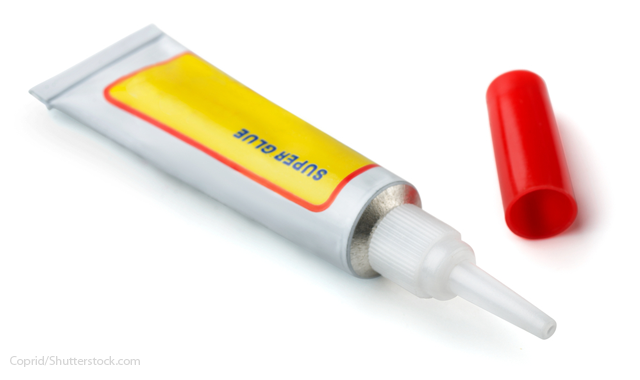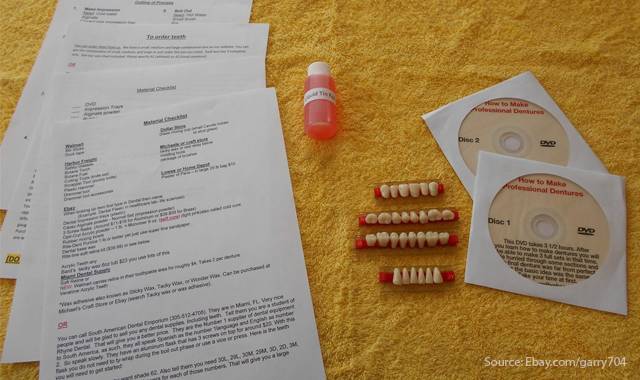The 5 craziest denture tips on the internet
For every good idea on the web, there are thousands of bad ones. These are some of the worst fixes out there.
As an expert on dental prostheses and restorations, you might take it for granted that you do excellent work.
But there is an entire corner of the internet that says, “I don’t need an expert for that, I can do it myself.” Here is what happens when non-experts try to get into the dental game.

You’ve spent years training to use the best materials and techniques to create the best product that is esthetic, safe and (most importantly) functional. The following groups of people spent a few hours using household objects and YouTube guides to make or fix their dentures.
After seeing some of the worst denture tips and “hacks” from across the internet, you’ll agree that the phrase “leave it to the experts” has never been truer.
Not only will these tips not create something long-lasting or beautiful, they may just be the worst thing a patient could put in their mouth. They might be cheaper in the short run, but these could end up costing patients a lot more in wasted materials or health problems.

Dentures by Ebay
It should go without saying that no one should ever get health tips from ebay. But at least 140 people didn’t realize that. Instead, they turned to Ebay user garry704 (100% positive feedback rating!) for a “very easy dvd kit for makeing [sic] your own dentures at home.”
This kit isn’t being auctioned off, instead it’s available to buy now for the low price of $35. Very reasonable! That $35 includes: two dvds, a printout of the additional materials you will need to purchase, another printout on how to order teeth, yet another printout with a materials checklist and finally a bottle of free liquid tin foil.
The additional materials will cost around $25 (at least according to garry704), meaning that an entire set of dentures will only run about $60. While certainly cheaper than most any other options, this kit will almost undoubtedly create further problems.
For example, while the description might claim all materials are only $25, the actual printout tells a different story. It suggests a Dremel unit from Home Depot, which run at least $50. There’s also a butane torch ($20), safety glasses ($10) and a generic order for “cutting tools,” which will probably cost a reasonable amount of money. The printout also suggests a 25lb bag of Plaster of Paris, which runs $17 and seems like an excessive amount of material.
According to the cover of the DVD, after a few attempts you will be able to complete 3 full denture sets in the 3.5 hours it takes to watch the instruction dvd - so perhaps it all comes down to a matter of quantity over quality.
But let’s say that you have all of those materials just sitting in your garage and that you also happen to be an amazingly talented craftsperson without any sort of formal training. There’s still the problem the problem of sanitation and safety. What if one of these dentures breaks while chewing? What if one of the teeth pops out and you swallow it? Can you make sure that the “duck tape” from Walmart meets safety standards?


Plastic and a butter knife
This handy YouTube guide promises to help you make $12 dentures in less than an hour. If that sounds too cheap to be good, you’re probably right.
This method only requires one material, polymorph pellets, a plastic bead sold in many craft stores (some are even cheaper than $12). To make the bridge, first melt the beads in a microwave. Then, while still warm, apply the melted plastic mass around the teeth to make a form. Once the form is completed, remove the plastic and use a butter knife heated in water to slowly shape the plastic into a tooth-like form. This will create very white teeth that can then be dyed using coffee or (as one commenter suggests) yellow food coloring.
The finished product does admittedly seem to work well in the video and the cost saving is certainly admirable - except for one potentially huge problem. During the forming process, the creator, “bigcatfishin,” stresses that you don’t want to let the plastic harden. Any procedure that could result in accidentally sealing a huge glob of plastic in your mouth seems inherently dangerous and could result in serious damage - not to mention the thousands of dollars it would take to repair that damage.



Crayons and candles
Most labs probably don’t have a drawer full of crayons - for good reason. But the website falseteethoptions.com sees no problem with using children’s craft supplies for something that goes into your mouth.
These dentures claim to be the cheapest of all - just five dollars! They’re also quick, taking only around 30 minutes from start to finish.
The base material, while not exactly ideal for this application, is at least made to be put into the mouth. The process starts with dental wax, the kind used to protect the mouth from braces that can be obtained from any pharmacy. Something you will not find in most drugstores, however, are this site’s instructions to first melt that wax in a spoon held over a candle.
That’s when it starts to go downhill quickly. The next step is to melt the wax of a white candle and add that to the dental wax. This is help firm up the dental wax enough to hold its shape - the site recommends about 10-15 percent candle wax in the mixture.
The next step goes even further. The wax is too white, so to color the teeth the site recommends melting crayons into the mixture. And not just one type of crayon - white, brown and yellow crayons should all come into play. Somehow, these colors will eventually match tooth color.
Next, shape the wax into a roughly tooth like shape and allow it to cool slightly. Place it into the mouth for a final fitting and then continue to shape it.
The website warns that this should only be used a temporary solution, but even that seems too long. Even the dental wax, the actually FDA-approved portion of this mixture, isn’t recommended for long term use -it’s listing says to remove it after a couple of days, because it “encourages bacteria growth.”
Crayons are made for kids and are usually safe, but it’s generally not recommended to eat them. Same with wax candles - though depending on the candle, those might have all sorts of strange chemicals (or bacteria) in them.


When a denture isn’t a denture
Improving appearance and self-confidence are certainly a key part of modern dentistry, but as perfect smile veneers demonstrate, that’s not enough. Structure and usability also matter a lot!
The Perfect Smile Veneer is made of a “special, non-toxic polymer,” so at least there’s no candle wax this time. And, while the $14.99 veneer isn’t exactly the world’s most esthetic option (the teeth are too white, the wax bulges outward, the color of the gums is off), it does at least provide a cheap option for covering up teeth. For those who can’t afford dental care, this might be the best cosmetic option.
The problem, however, is directly in the commercial (and featured prominently on the bottom of their website). “This product is only intended to enhance your appearance, and isn't a denture or a dental device.” While this product might make you look a little better, it really isn’t much of help at all.
The FAQ page presents an even bleaker picture: “Do not wear Perfect Smile when eating; although it is possible to drink while wearing it.” There is also the danger that during fitting the impression material can cling to the roof of the mouth, impeding speech. The veneer also only comes in one size, claiming to be a one-size-fits-all approach - but what about patients with smaller or larger mouths? What about patients who struggle to mold the veneer? $15 might seems like a steal, but it’s no substitute for a custom-fitted denture.



Dentures by super glue
Angie Barlow, a 48-year-old British woman, made headlines for her dental work. Barlow was afraid of the dentist and hadn’t been in years. However, she had severe dental problems - her teeth were falling out due to a heavy smoking habit.
Her solution? Super glue. When a tooth would fall out, she would apply a small amount of glue to the top and then stick it back in to avoid a gap. Over time, this resulted in a kind of super glue denture because of the amount of glue in her mouth. The super glue fix weakened her bones and remaining teeth, to the point where she had to have 11 teeth extracted and replaced with implants.
Barlow’s case probably isn’t an isolated one. There are multipleguidestoutingthe powerof super glue for fixing dentures out there on the internet (though helpfully, many dental officeshave posts warning against the practice). Some claim that the glue is only toxic in liquid form, others dismiss claims that super glue should not be used in damp environments, others ignore the probable long-term damage to their dentures. As with most things on the internet, it’s too good and too cheap to be true.

Nexa3D Announces A Pair of Distribution Partners and Compatibility With a Trio of Pac-Dent Resins
February 27th 20243D printer manufacturer Nexa3D recently announce new distribution partnerships with CAD-Ray and Harris Discount Dental Supply, along with compatibility with 3 of Pac-Dent’s Rodin resins.
